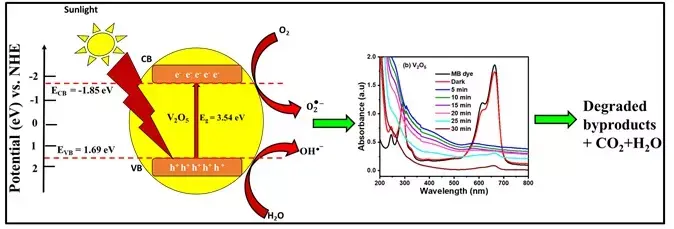Effect of surfactant on structural and optical properties of V2O5 nanocrystals as a potential catalyst for photodegradation
Authors
- F. M. Sanakousar 1
- C. C. Vidyasagar * 1
- S. Chigari Swapna 1
-
Victor M. Jiménez-Pérez
 2
2
- C. C. Viswanath 3
- K. Prakash 4
- M. B. Sridhara 1
Abstract
An anionic, cationic, and non-ionic surfactant-assisted wet chemical method was used to synthesize vanadium pentoxide (V2O5) nanocrystals. XRD, FESEM, EDX, FTIR, UV-Vis, and PL techniques were used to characterize the V2O5 nanocrystals. The formation of V2O5 nanocrystals is confirmed by the experimental results. The addition of surfactants had a significant effect on the morphology, crystallinity, and optoelectronic characteristics of the prepared photocatalysts, as per the detailed characterization and analysis of the pertaining light-matter interactions. Additionally, the Scherrer and William-Hall plot methods were used to determine the crystallite sizes from the broadening of the XRD peak. Surfactant addition caused the sample bandgap to broaden, resulting in the blue shift in the distinctive absorption peak of V2O5 nanocrystals. To effectively separate the charge carriers during photocatalysis, the most effective photocatalyst (pure V2O5) material showed small crystallite size and short migration routes for the charge carriers which is confirmed by XRD and PL analysis. Pure V2O5 nanocrystals showed excellent yields in the photocatalytic degradation of Methylene Blue (MB) dye when exposed to sunlight compared to surfactant-assisted V2O5. The V2O5 catalyst’s photostability and reusability were also assessed; after four cycles of testing, the percentage degradation of MB was 94.75%. As per the scavenger experiment, photo-generated holes (h+) and superoxide radical’s anions (O2‾.) are the major species responsible for the degradation of MB dye. There is a suggested mechanism for the higher degradation efficiency of V2O5 at neutral pH when exposed to sunlight. Pure V2O5 is a promising and effective photo-catalyst for the photocatalytic degradation of MB dye due to its extremely high performance.
Highlights
- The effect of surfactants on the structural and optical properties of V2O5 was studied.
- Higher charge separation of the pure V2O5 based on the results of PL spectroscopy.
- Pure V2O5 showed the best photoactivity in 10 ppm MB dye over a 0.01 g catalyst at natural pH under sunlight irradiation.
- The primary role of holes and superoxide radicals in the MB mechanism was investigated.
- The recycled pure V2O5 catalyst acquired strong stability and durability.





